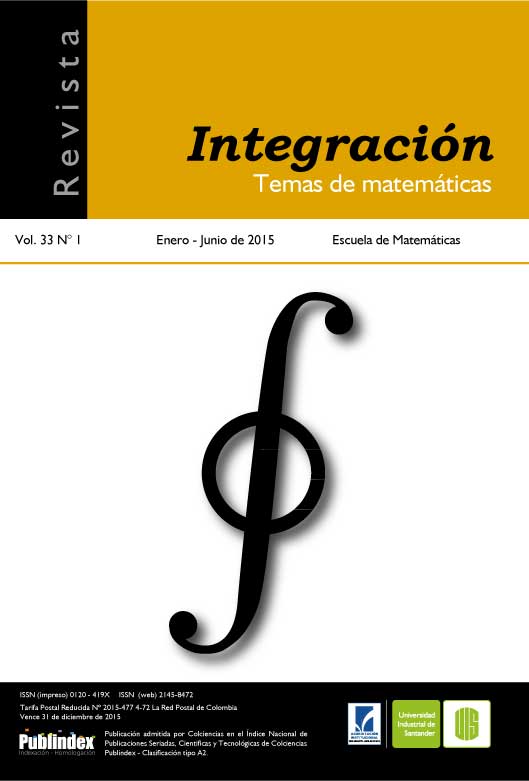Research and Innovation Articles
Weak-type (1,1) bounds for a class of operators with discrete kernel
Published 2015-05-21
Keywords
- Lp spaces,
- discrete operator,
- pseudo-differential operator,
- Calderón-Zygmund decomposition
How to Cite
Cardona, D. (2015). Weak-type (1,1) bounds for a class of operators with discrete kernel. Revista Integración, Temas De matemáticas, 33(1), 51–60. Retrieved from https://revistas.uis.edu.co/index.php/revistaintegracion/article/view/4769
Abstract
In this paper we investigate the weak continuity of a certain class of operators with kernel defined on Z×Z. We prove some results on the weak boundedness of discrete analogues of Calderón Zygmund operators. The considered operators arise from the study of discrete pseudo-differential operators and discrete analogues of singular integral operators.
To cite this article: D. Cardona, Weak-type (1,1) bounds for a class of operators with discrete kernel, Rev. Integr. Temas Mat. 33 (2015), no. 1, 51-60.Downloads
Download data is not yet available.
References
- Bober J., Carneiro E., Hughes K. and Pierce L., “On a discrete version of Tanaka’s theorem for maximal functions”, Proc. Amer. Math. Soc. 140 (2012), no. 5, 1669-1680.
- Calderón A.P. and Zygmund A., “On the existence of certain singular integrals”, Acta Math. 88 (1952), 85-139.
- Cardona D., “Invertibilidad de operadores pseudo diferenciales definidos en Zn”, Lect. Mat. 34 (2013), no. 2, 179-186.
- Carneiro E. and Hughes K., “On the endpoint regularity of discrete maximal operators”, Math. Res. Lett. 19 (2012), no. 6, 1245-1262.
- Carro M., “Discretization of linear operators on Lp(Rn)”, Illinois J. Math. 42 (1998), no. 1, 1-18.
- Duoandikoetxea J., Fourier Analysis, American Mathematical Society, Providence, RI, 2001.
- Grafakos L., “An elementary proof of the square summability of the discrete Hilbert transform”, Amer. Math. Monthly. 101 (1994), no. 5, 456-458.
- Hughes K.J. Jr., “Arithmetic analogues in harmonic analysis: Results related to Waring’s problem”, Thesis (Ph.D.), Princeton University, 2012, 112 p.
- Kikuchi N., Nakai E., Tomita N., Yabuta K. and Yoneda T., “Calderón-Zygmund operators on amalgam spaces and in the discrete case”, J. Math. Anal. Appl. 335 (2007), no. 1, 198-
- Marcinkiewicz J., “Sur l’interpolation d’operations”, C. R. Acad. Sci. Paris. 208 (1939),1272-1273.
- Mirek M., “Weak type (1,1) inequalities for discrete rough maximal functions”, arXiv:1305.0575v2 (2014).
- Molahajloo S., “Pseudo-differential operators on Z : Pseudo-differential operators: complex analysis and partial differential equations”, Oper. Theory. Adv. Appl. 205 (2010), 213-221.
- Pierce L., “Discrete analogues in harmonic analysis”, Thesis (Ph.D), Princeton University, 2009, 321 p.
- Riesz M., “Sur les fonctions conjuguées”, Math. Z. 27 (1928), no.1, 218-244.
- Rodriguez C.A., “Lp−estimates for pseudo-differential operators on Zn”, J. Pseudo-Differ. Oper. Appl. 1 (2011), 183-205.
- Stein E., Harmonic Analysis: real-variable methods, orthogonality, and oscillatory integrals, Princeton University Press, Princeton, 1993.
- Stein E. and Wainger S., “Discrete analogues of singular Radon transforms”, Bull. Amer. Math. Soc. (N.S.). 23 (1990), no. 2, 537-544.
- Stein E. and Wainger S., “Discrete analogues in harmonic analysis. I. l 2 estimates for singular Radon transforms”, Amer. J. Math. 121 (1999), no. 6, 1291-1336.
- Stein E. and Wainger S., “Discrete analogues in harmonic analysis, II. Fractional integration”, J. Anal. Math. 80 (2000), 335-355.
- Urban R. and Zienkiewicz J., “Weak type (1,1) estimates for a class of discrete rough maximal functions”, Math. Res. Lett. 14 (2007), no. 2, 227-237.
- Wong M.W., Discrete Fourier Analysis. Birkhäuser/
- Springer Basel AG, Basel, 2011.
- Zygmund A., “On a theorem of Marcinkiewicz concerning interpolation of operations”, J. Math. Pures. Appl. 35 (1956), no. 9, 223-248.
